Management of People and Teams Report: MGT600, Semester 2 Analysis
VerifiedAdded on 2023/03/20
|7
|1847
|23
Report
AI Summary
This report provides a comprehensive analysis of various management theories, including contingency theory, theory X and Y, systems theory, and scientific management theory, and their application in enhancing organizational and individual performance. It delves into the contrasting concepts of theory X and theory Y, exploring authoritarian and participative management styles, and their relevance in motivating employees. The report also examines different communication styles—passive, passive-aggressive, assertive, and aggressive—and their impact on team dynamics, particularly emphasizing the effectiveness of assertive communication. Furthermore, it assesses the presenter's communication style and the strengths and weaknesses of the presentation, offering suggestions for improvement. The report concludes by highlighting the importance of management theories in boosting productivity, simplifying decision-making, and encouraging employee involvement.
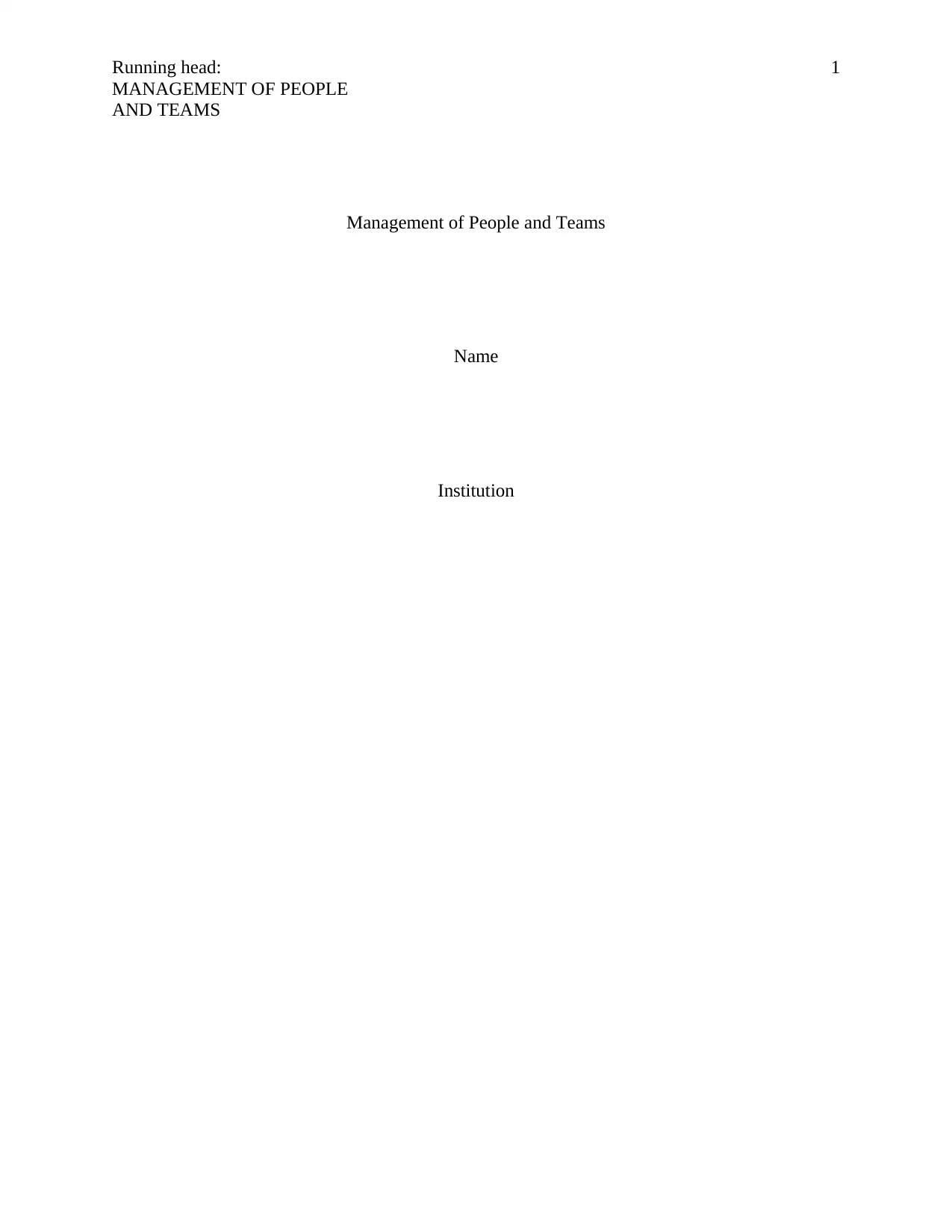
Running head:
MANAGEMENT OF PEOPLE
AND TEAMS
1
Management of People and Teams
Name
Institution
MANAGEMENT OF PEOPLE
AND TEAMS
1
Management of People and Teams
Name
Institution
Paraphrase This Document
Need a fresh take? Get an instant paraphrase of this document with our AI Paraphraser
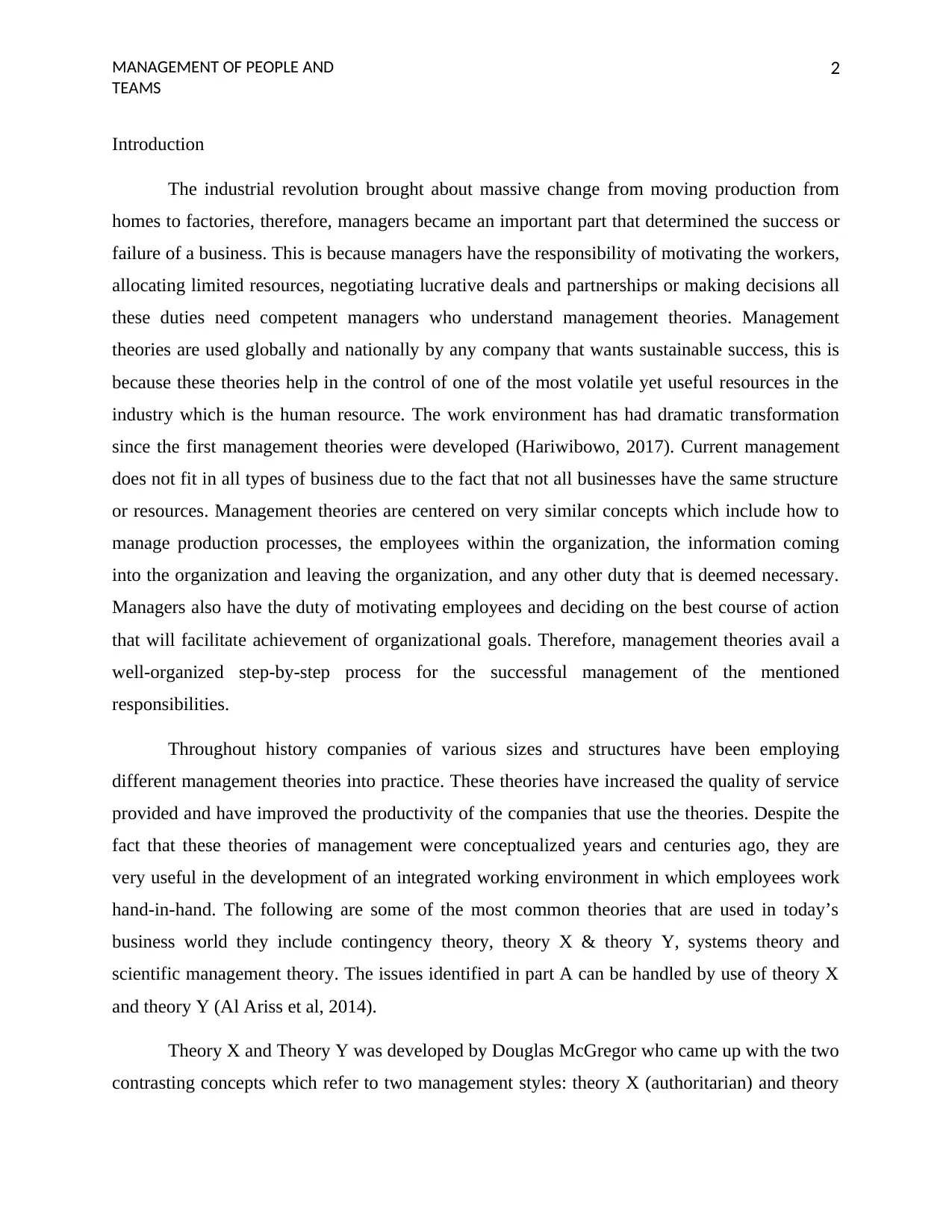
MANAGEMENT OF PEOPLE AND
TEAMS
2
Introduction
The industrial revolution brought about massive change from moving production from
homes to factories, therefore, managers became an important part that determined the success or
failure of a business. This is because managers have the responsibility of motivating the workers,
allocating limited resources, negotiating lucrative deals and partnerships or making decisions all
these duties need competent managers who understand management theories. Management
theories are used globally and nationally by any company that wants sustainable success, this is
because these theories help in the control of one of the most volatile yet useful resources in the
industry which is the human resource. The work environment has had dramatic transformation
since the first management theories were developed (Hariwibowo, 2017). Current management
does not fit in all types of business due to the fact that not all businesses have the same structure
or resources. Management theories are centered on very similar concepts which include how to
manage production processes, the employees within the organization, the information coming
into the organization and leaving the organization, and any other duty that is deemed necessary.
Managers also have the duty of motivating employees and deciding on the best course of action
that will facilitate achievement of organizational goals. Therefore, management theories avail a
well-organized step-by-step process for the successful management of the mentioned
responsibilities.
Throughout history companies of various sizes and structures have been employing
different management theories into practice. These theories have increased the quality of service
provided and have improved the productivity of the companies that use the theories. Despite the
fact that these theories of management were conceptualized years and centuries ago, they are
very useful in the development of an integrated working environment in which employees work
hand-in-hand. The following are some of the most common theories that are used in today’s
business world they include contingency theory, theory X & theory Y, systems theory and
scientific management theory. The issues identified in part A can be handled by use of theory X
and theory Y (Al Ariss et al, 2014).
Theory X and Theory Y was developed by Douglas McGregor who came up with the two
contrasting concepts which refer to two management styles: theory X (authoritarian) and theory
TEAMS
2
Introduction
The industrial revolution brought about massive change from moving production from
homes to factories, therefore, managers became an important part that determined the success or
failure of a business. This is because managers have the responsibility of motivating the workers,
allocating limited resources, negotiating lucrative deals and partnerships or making decisions all
these duties need competent managers who understand management theories. Management
theories are used globally and nationally by any company that wants sustainable success, this is
because these theories help in the control of one of the most volatile yet useful resources in the
industry which is the human resource. The work environment has had dramatic transformation
since the first management theories were developed (Hariwibowo, 2017). Current management
does not fit in all types of business due to the fact that not all businesses have the same structure
or resources. Management theories are centered on very similar concepts which include how to
manage production processes, the employees within the organization, the information coming
into the organization and leaving the organization, and any other duty that is deemed necessary.
Managers also have the duty of motivating employees and deciding on the best course of action
that will facilitate achievement of organizational goals. Therefore, management theories avail a
well-organized step-by-step process for the successful management of the mentioned
responsibilities.
Throughout history companies of various sizes and structures have been employing
different management theories into practice. These theories have increased the quality of service
provided and have improved the productivity of the companies that use the theories. Despite the
fact that these theories of management were conceptualized years and centuries ago, they are
very useful in the development of an integrated working environment in which employees work
hand-in-hand. The following are some of the most common theories that are used in today’s
business world they include contingency theory, theory X & theory Y, systems theory and
scientific management theory. The issues identified in part A can be handled by use of theory X
and theory Y (Al Ariss et al, 2014).
Theory X and Theory Y was developed by Douglas McGregor who came up with the two
contrasting concepts which refer to two management styles: theory X (authoritarian) and theory
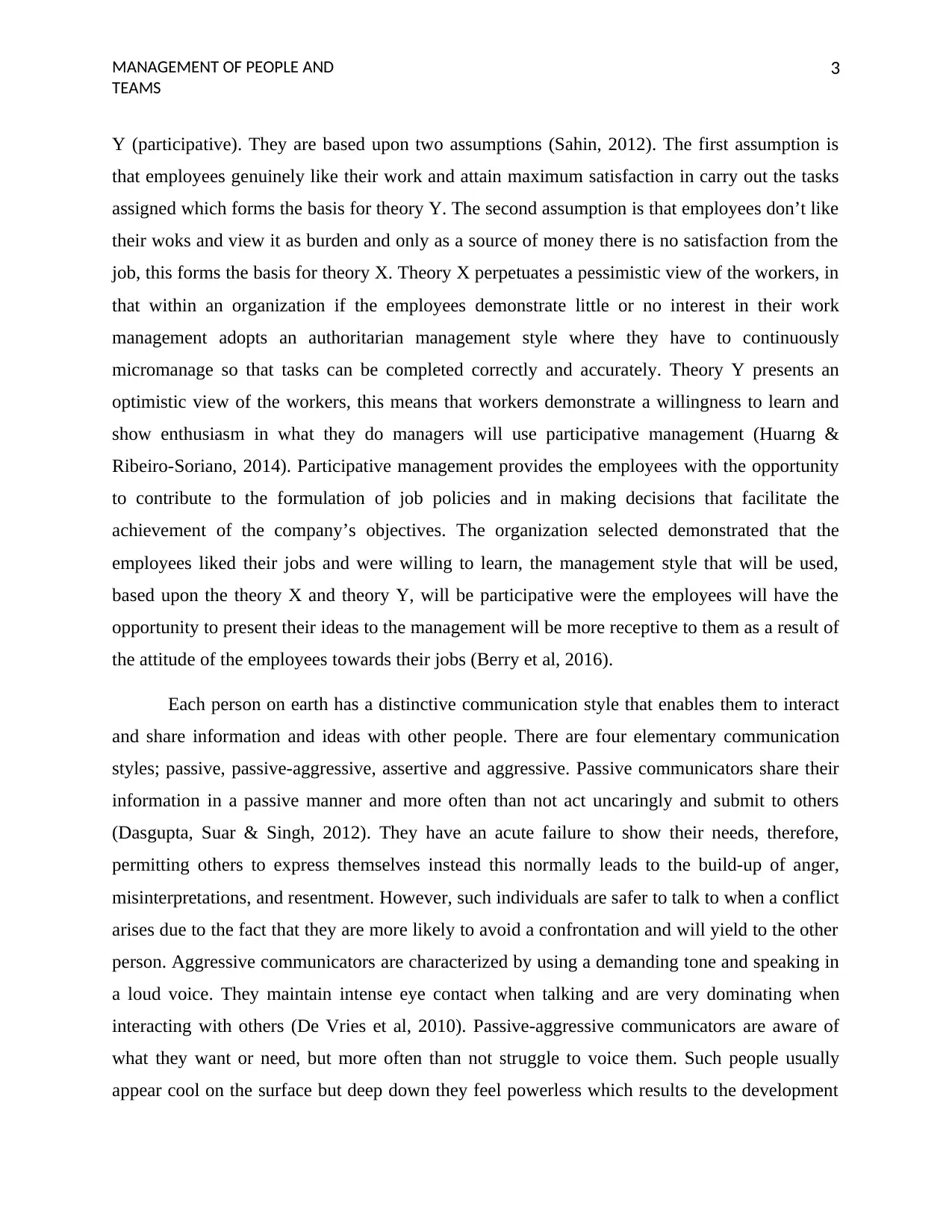
MANAGEMENT OF PEOPLE AND
TEAMS
3
Y (participative). They are based upon two assumptions (Sahin, 2012). The first assumption is
that employees genuinely like their work and attain maximum satisfaction in carry out the tasks
assigned which forms the basis for theory Y. The second assumption is that employees don’t like
their woks and view it as burden and only as a source of money there is no satisfaction from the
job, this forms the basis for theory X. Theory X perpetuates a pessimistic view of the workers, in
that within an organization if the employees demonstrate little or no interest in their work
management adopts an authoritarian management style where they have to continuously
micromanage so that tasks can be completed correctly and accurately. Theory Y presents an
optimistic view of the workers, this means that workers demonstrate a willingness to learn and
show enthusiasm in what they do managers will use participative management (Huarng &
Ribeiro-Soriano, 2014). Participative management provides the employees with the opportunity
to contribute to the formulation of job policies and in making decisions that facilitate the
achievement of the company’s objectives. The organization selected demonstrated that the
employees liked their jobs and were willing to learn, the management style that will be used,
based upon the theory X and theory Y, will be participative were the employees will have the
opportunity to present their ideas to the management will be more receptive to them as a result of
the attitude of the employees towards their jobs (Berry et al, 2016).
Each person on earth has a distinctive communication style that enables them to interact
and share information and ideas with other people. There are four elementary communication
styles; passive, passive-aggressive, assertive and aggressive. Passive communicators share their
information in a passive manner and more often than not act uncaringly and submit to others
(Dasgupta, Suar & Singh, 2012). They have an acute failure to show their needs, therefore,
permitting others to express themselves instead this normally leads to the build-up of anger,
misinterpretations, and resentment. However, such individuals are safer to talk to when a conflict
arises due to the fact that they are more likely to avoid a confrontation and will yield to the other
person. Aggressive communicators are characterized by using a demanding tone and speaking in
a loud voice. They maintain intense eye contact when talking and are very dominating when
interacting with others (De Vries et al, 2010). Passive-aggressive communicators are aware of
what they want or need, but more often than not struggle to voice them. Such people usually
appear cool on the surface but deep down they feel powerless which results to the development
TEAMS
3
Y (participative). They are based upon two assumptions (Sahin, 2012). The first assumption is
that employees genuinely like their work and attain maximum satisfaction in carry out the tasks
assigned which forms the basis for theory Y. The second assumption is that employees don’t like
their woks and view it as burden and only as a source of money there is no satisfaction from the
job, this forms the basis for theory X. Theory X perpetuates a pessimistic view of the workers, in
that within an organization if the employees demonstrate little or no interest in their work
management adopts an authoritarian management style where they have to continuously
micromanage so that tasks can be completed correctly and accurately. Theory Y presents an
optimistic view of the workers, this means that workers demonstrate a willingness to learn and
show enthusiasm in what they do managers will use participative management (Huarng &
Ribeiro-Soriano, 2014). Participative management provides the employees with the opportunity
to contribute to the formulation of job policies and in making decisions that facilitate the
achievement of the company’s objectives. The organization selected demonstrated that the
employees liked their jobs and were willing to learn, the management style that will be used,
based upon the theory X and theory Y, will be participative were the employees will have the
opportunity to present their ideas to the management will be more receptive to them as a result of
the attitude of the employees towards their jobs (Berry et al, 2016).
Each person on earth has a distinctive communication style that enables them to interact
and share information and ideas with other people. There are four elementary communication
styles; passive, passive-aggressive, assertive and aggressive. Passive communicators share their
information in a passive manner and more often than not act uncaringly and submit to others
(Dasgupta, Suar & Singh, 2012). They have an acute failure to show their needs, therefore,
permitting others to express themselves instead this normally leads to the build-up of anger,
misinterpretations, and resentment. However, such individuals are safer to talk to when a conflict
arises due to the fact that they are more likely to avoid a confrontation and will yield to the other
person. Aggressive communicators are characterized by using a demanding tone and speaking in
a loud voice. They maintain intense eye contact when talking and are very dominating when
interacting with others (De Vries et al, 2010). Passive-aggressive communicators are aware of
what they want or need, but more often than not struggle to voice them. Such people usually
appear cool on the surface but deep down they feel powerless which results to the development
⊘ This is a preview!⊘
Do you want full access?
Subscribe today to unlock all pages.

Trusted by 1+ million students worldwide
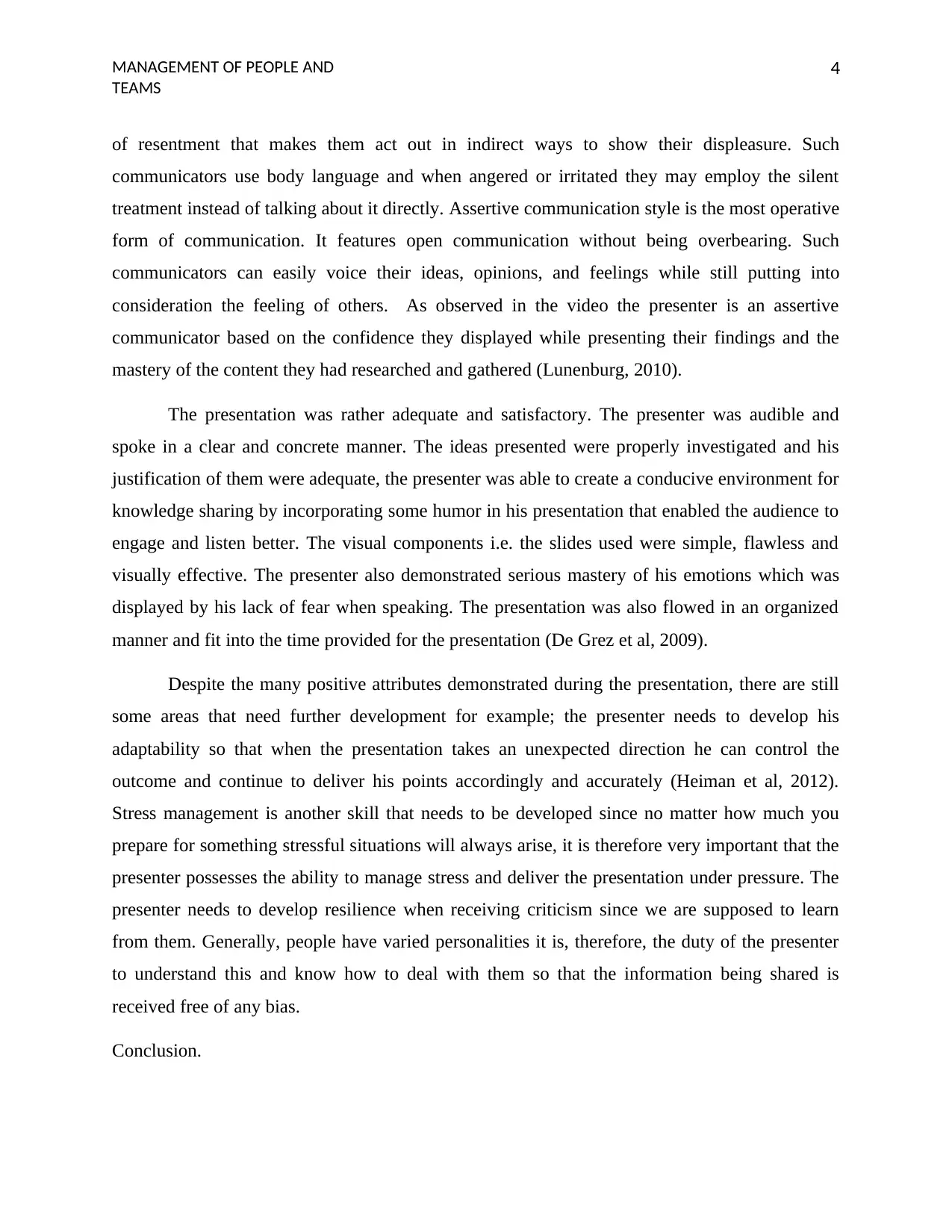
MANAGEMENT OF PEOPLE AND
TEAMS
4
of resentment that makes them act out in indirect ways to show their displeasure. Such
communicators use body language and when angered or irritated they may employ the silent
treatment instead of talking about it directly. Assertive communication style is the most operative
form of communication. It features open communication without being overbearing. Such
communicators can easily voice their ideas, opinions, and feelings while still putting into
consideration the feeling of others. As observed in the video the presenter is an assertive
communicator based on the confidence they displayed while presenting their findings and the
mastery of the content they had researched and gathered (Lunenburg, 2010).
The presentation was rather adequate and satisfactory. The presenter was audible and
spoke in a clear and concrete manner. The ideas presented were properly investigated and his
justification of them were adequate, the presenter was able to create a conducive environment for
knowledge sharing by incorporating some humor in his presentation that enabled the audience to
engage and listen better. The visual components i.e. the slides used were simple, flawless and
visually effective. The presenter also demonstrated serious mastery of his emotions which was
displayed by his lack of fear when speaking. The presentation was also flowed in an organized
manner and fit into the time provided for the presentation (De Grez et al, 2009).
Despite the many positive attributes demonstrated during the presentation, there are still
some areas that need further development for example; the presenter needs to develop his
adaptability so that when the presentation takes an unexpected direction he can control the
outcome and continue to deliver his points accordingly and accurately (Heiman et al, 2012).
Stress management is another skill that needs to be developed since no matter how much you
prepare for something stressful situations will always arise, it is therefore very important that the
presenter possesses the ability to manage stress and deliver the presentation under pressure. The
presenter needs to develop resilience when receiving criticism since we are supposed to learn
from them. Generally, people have varied personalities it is, therefore, the duty of the presenter
to understand this and know how to deal with them so that the information being shared is
received free of any bias.
Conclusion.
TEAMS
4
of resentment that makes them act out in indirect ways to show their displeasure. Such
communicators use body language and when angered or irritated they may employ the silent
treatment instead of talking about it directly. Assertive communication style is the most operative
form of communication. It features open communication without being overbearing. Such
communicators can easily voice their ideas, opinions, and feelings while still putting into
consideration the feeling of others. As observed in the video the presenter is an assertive
communicator based on the confidence they displayed while presenting their findings and the
mastery of the content they had researched and gathered (Lunenburg, 2010).
The presentation was rather adequate and satisfactory. The presenter was audible and
spoke in a clear and concrete manner. The ideas presented were properly investigated and his
justification of them were adequate, the presenter was able to create a conducive environment for
knowledge sharing by incorporating some humor in his presentation that enabled the audience to
engage and listen better. The visual components i.e. the slides used were simple, flawless and
visually effective. The presenter also demonstrated serious mastery of his emotions which was
displayed by his lack of fear when speaking. The presentation was also flowed in an organized
manner and fit into the time provided for the presentation (De Grez et al, 2009).
Despite the many positive attributes demonstrated during the presentation, there are still
some areas that need further development for example; the presenter needs to develop his
adaptability so that when the presentation takes an unexpected direction he can control the
outcome and continue to deliver his points accordingly and accurately (Heiman et al, 2012).
Stress management is another skill that needs to be developed since no matter how much you
prepare for something stressful situations will always arise, it is therefore very important that the
presenter possesses the ability to manage stress and deliver the presentation under pressure. The
presenter needs to develop resilience when receiving criticism since we are supposed to learn
from them. Generally, people have varied personalities it is, therefore, the duty of the presenter
to understand this and know how to deal with them so that the information being shared is
received free of any bias.
Conclusion.
Paraphrase This Document
Need a fresh take? Get an instant paraphrase of this document with our AI Paraphraser
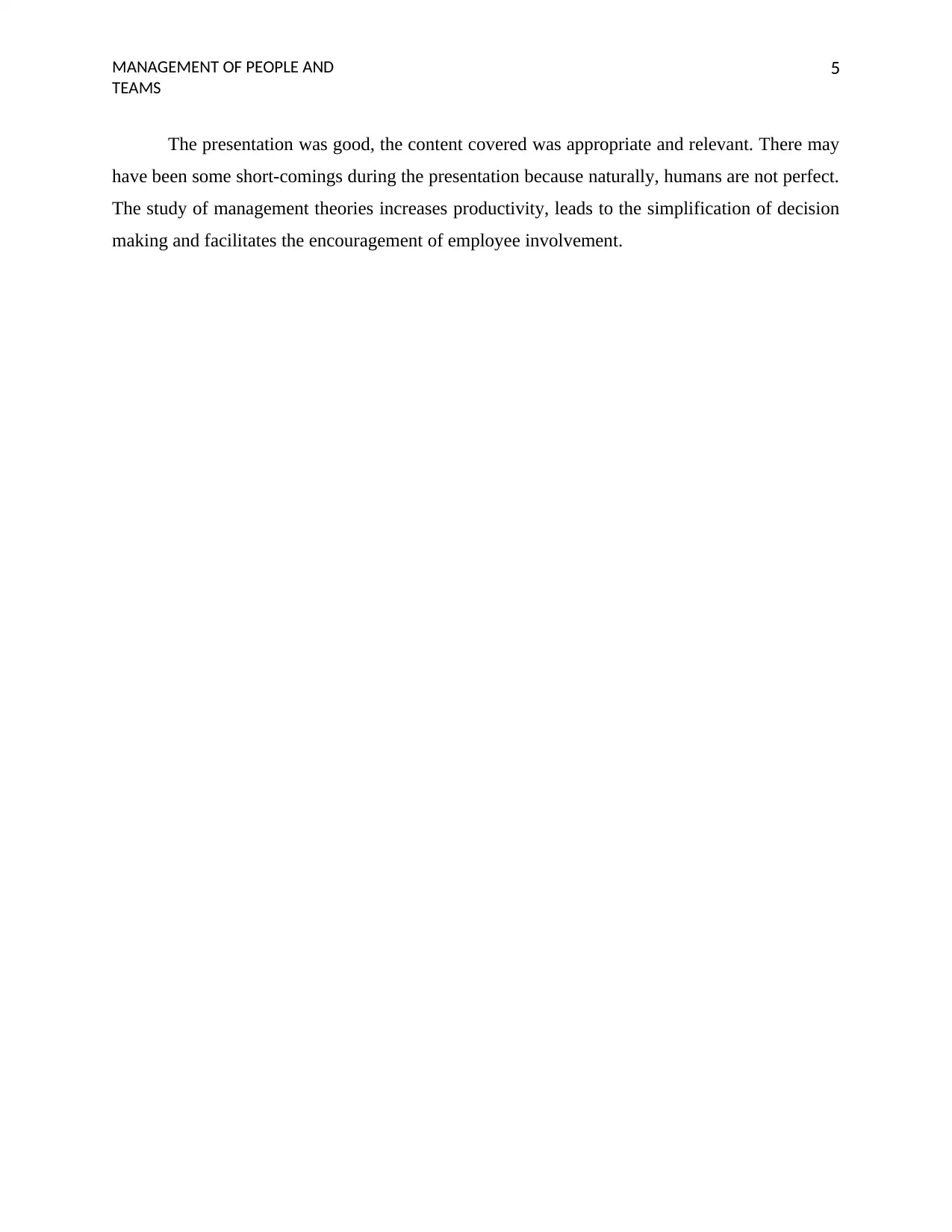
MANAGEMENT OF PEOPLE AND
TEAMS
5
The presentation was good, the content covered was appropriate and relevant. There may
have been some short-comings during the presentation because naturally, humans are not perfect.
The study of management theories increases productivity, leads to the simplification of decision
making and facilitates the encouragement of employee involvement.
TEAMS
5
The presentation was good, the content covered was appropriate and relevant. There may
have been some short-comings during the presentation because naturally, humans are not perfect.
The study of management theories increases productivity, leads to the simplification of decision
making and facilitates the encouragement of employee involvement.
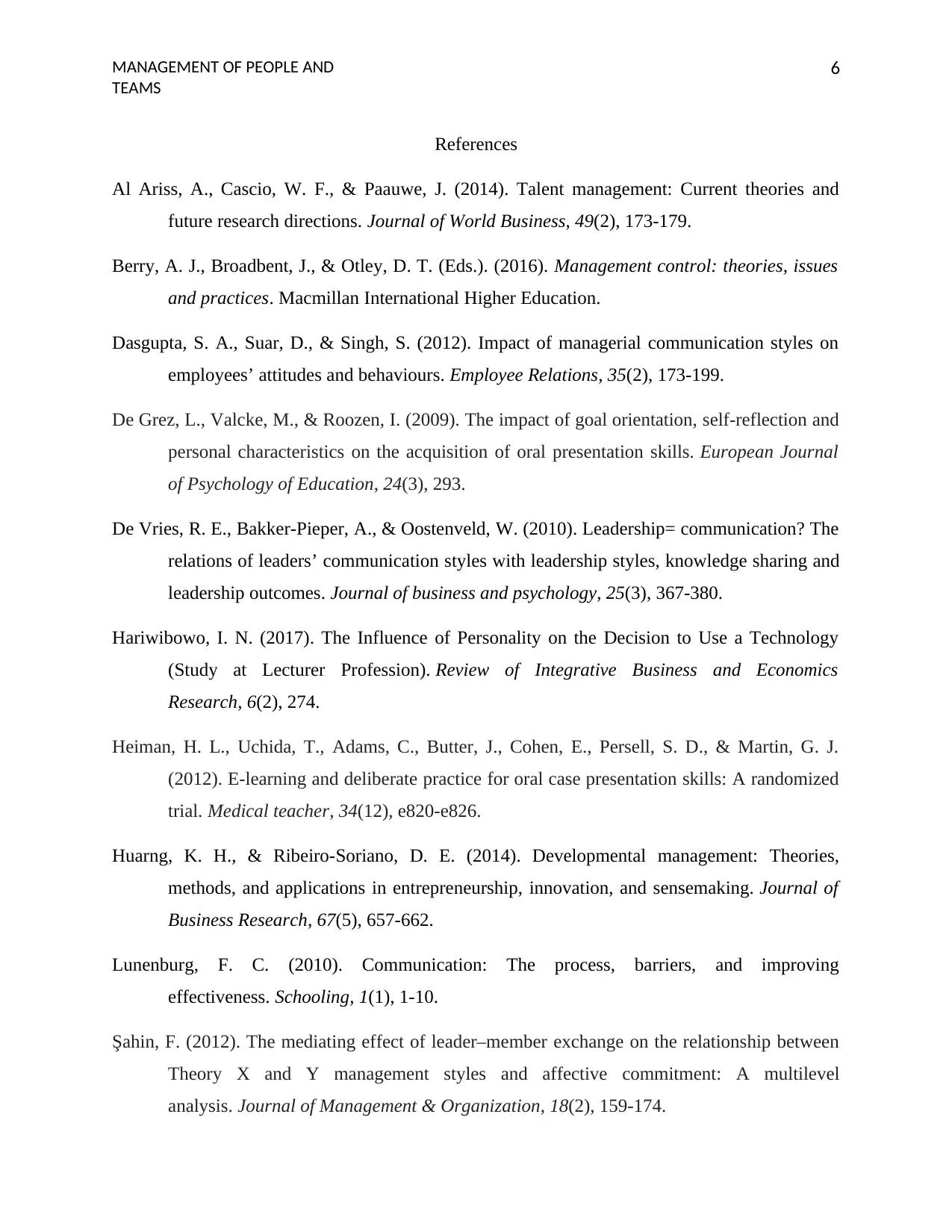
MANAGEMENT OF PEOPLE AND
TEAMS
6
References
Al Ariss, A., Cascio, W. F., & Paauwe, J. (2014). Talent management: Current theories and
future research directions. Journal of World Business, 49(2), 173-179.
Berry, A. J., Broadbent, J., & Otley, D. T. (Eds.). (2016). Management control: theories, issues
and practices. Macmillan International Higher Education.
Dasgupta, S. A., Suar, D., & Singh, S. (2012). Impact of managerial communication styles on
employees’ attitudes and behaviours. Employee Relations, 35(2), 173-199.
De Grez, L., Valcke, M., & Roozen, I. (2009). The impact of goal orientation, self-reflection and
personal characteristics on the acquisition of oral presentation skills. European Journal
of Psychology of Education, 24(3), 293.
De Vries, R. E., Bakker-Pieper, A., & Oostenveld, W. (2010). Leadership= communication? The
relations of leaders’ communication styles with leadership styles, knowledge sharing and
leadership outcomes. Journal of business and psychology, 25(3), 367-380.
Hariwibowo, I. N. (2017). The Influence of Personality on the Decision to Use a Technology
(Study at Lecturer Profession). Review of Integrative Business and Economics
Research, 6(2), 274.
Heiman, H. L., Uchida, T., Adams, C., Butter, J., Cohen, E., Persell, S. D., & Martin, G. J.
(2012). E-learning and deliberate practice for oral case presentation skills: A randomized
trial. Medical teacher, 34(12), e820-e826.
Huarng, K. H., & Ribeiro-Soriano, D. E. (2014). Developmental management: Theories,
methods, and applications in entrepreneurship, innovation, and sensemaking. Journal of
Business Research, 67(5), 657-662.
Lunenburg, F. C. (2010). Communication: The process, barriers, and improving
effectiveness. Schooling, 1(1), 1-10.
Şahin, F. (2012). The mediating effect of leader–member exchange on the relationship between
Theory X and Y management styles and affective commitment: A multilevel
analysis. Journal of Management & Organization, 18(2), 159-174.
TEAMS
6
References
Al Ariss, A., Cascio, W. F., & Paauwe, J. (2014). Talent management: Current theories and
future research directions. Journal of World Business, 49(2), 173-179.
Berry, A. J., Broadbent, J., & Otley, D. T. (Eds.). (2016). Management control: theories, issues
and practices. Macmillan International Higher Education.
Dasgupta, S. A., Suar, D., & Singh, S. (2012). Impact of managerial communication styles on
employees’ attitudes and behaviours. Employee Relations, 35(2), 173-199.
De Grez, L., Valcke, M., & Roozen, I. (2009). The impact of goal orientation, self-reflection and
personal characteristics on the acquisition of oral presentation skills. European Journal
of Psychology of Education, 24(3), 293.
De Vries, R. E., Bakker-Pieper, A., & Oostenveld, W. (2010). Leadership= communication? The
relations of leaders’ communication styles with leadership styles, knowledge sharing and
leadership outcomes. Journal of business and psychology, 25(3), 367-380.
Hariwibowo, I. N. (2017). The Influence of Personality on the Decision to Use a Technology
(Study at Lecturer Profession). Review of Integrative Business and Economics
Research, 6(2), 274.
Heiman, H. L., Uchida, T., Adams, C., Butter, J., Cohen, E., Persell, S. D., & Martin, G. J.
(2012). E-learning and deliberate practice for oral case presentation skills: A randomized
trial. Medical teacher, 34(12), e820-e826.
Huarng, K. H., & Ribeiro-Soriano, D. E. (2014). Developmental management: Theories,
methods, and applications in entrepreneurship, innovation, and sensemaking. Journal of
Business Research, 67(5), 657-662.
Lunenburg, F. C. (2010). Communication: The process, barriers, and improving
effectiveness. Schooling, 1(1), 1-10.
Şahin, F. (2012). The mediating effect of leader–member exchange on the relationship between
Theory X and Y management styles and affective commitment: A multilevel
analysis. Journal of Management & Organization, 18(2), 159-174.
⊘ This is a preview!⊘
Do you want full access?
Subscribe today to unlock all pages.

Trusted by 1+ million students worldwide

MANAGEMENT OF PEOPLE AND
TEAMS
7
TEAMS
7
1 out of 7
Related Documents
Your All-in-One AI-Powered Toolkit for Academic Success.
+13062052269
info@desklib.com
Available 24*7 on WhatsApp / Email
![[object Object]](/_next/static/media/star-bottom.7253800d.svg)
Unlock your academic potential
Copyright © 2020–2025 A2Z Services. All Rights Reserved. Developed and managed by ZUCOL.




